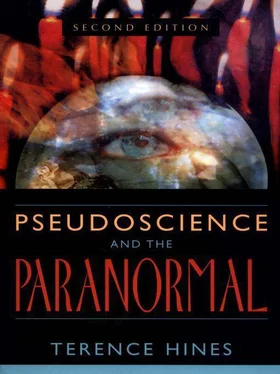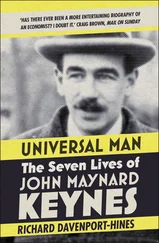Another characteristic of many pseudosciences is the failure of the proponents to change or update their theories in the light of new evidence. For example, in 1950 Immanuel Velikovsky put forward his theory of “worlds in collision” (see chapter 9). Knowledge of the solar system in particular and astronomy in general changed vastly in the thirty-two years between 1950 and Velikovsky’s death in 1982. Yet not once during that period did Velikovsky change his theories to reflect this new knowledge. Like many proponents of pseudoscience, he felt the theory was written in stone. It was, so to speak, revealed truth not to be changed by mere facts. If the facts don’t fit, the proponents of pseudoscience prefer to ignore the facts. The theory must be preserved at all costs.
This is rather ironic, as I suspect the general public’s impression is that scientists are conservative, closed-minded, stodgy folk who rarely change their minds. In fact, nothing could be further from the truth. In the last thirty years all areas of scientific investigation have undergone radical changes. New theories have appeared, been useful for a time, then given way to even newer theories as new data and facts have demonstrated that the old theories were inadequate. Science changes so rapidly, it is frequently difficult to keep up with the changes even in one’s own field. This is in contrast, of course, to the pseudoscientists, whose theories almost never change. Again, if one looks at the actual behavior of scientists and pseudoscientists, it is clear which is really the more open-minded of the two groups.
The characteristics of pseudoscience discussed in this chapter may not permit one to determine with precision whether a specific claim or belief system is a pseudoscience. But they do offer some useful guidelines. As applied in the following chapters, which examine various areas of pseudoscience, these criteria should help readers determine whether specific claims and arguments are pseudoscientific or not.
The paranormal can best be thought of as a subset of pseudoscience. What sets the paranormal apart from other pseudosciences is a reliance on explanations for alleged phenomena that are well outside the bounds of established science. Thus, paranormal phenomena include extrasensory perception (ESP), telekinesis, ghosts, poltergeists, life after death, reincarnation, faith healing, human auras, and so forth. The explanations for these allied phenomena are phrased in vague terms of “psychic forces,” “human energy fields,” and so on. This is in contrast to many pseudoscientific explanations for other nonparanormal phenomena, which, although very bad science, are still couched in acceptable scientific terms. Thus chelation therapy, a popular bit of medical quackery, is said to remove calcium from clogged arteries when the chemical ethylenediamine tetraacetate (EDTA) is given. The specific claim is that EDTA binds to calcium, thus destroying material blocking arteries. Binding of one substance to another is a real and very important biochemical process. However, the claims of the chelation therapists are simply wrong (Bennett 1985; Richmond 1985–86; Yetiv 1986; Green and Sampson 2002), and the therapy is not effective. So the claims for chelation therapy are pseudoscientific, but not paranormal.
However, the boundary between paranormal and nonparanormal pseudosciences is often fuzzy. Different individuals may give different types of explanations for the same alleged phenomena. Thus, the claims that UFOs are extraterrestrial spacecraft is generally a pseudoscientific one (see chapters 7 and 8). But some UFOlogists, such as Vallee (1975), now argue that UFOs are really some sort of psychic projection. This transforms the phenomenon into a paranormal one. Similarly, Mack (1999) argues that we live in a universe of many dimensions and that UFO aliens are spirits (or some such) from these other dimensions
Another example concerns biorhythms (discussed in chapter 6). The pseudoscientific explanation of these alleged effects is that the rhythms are set at the moment of birth in the individual’s brain (Mallardi 1978). Attempts are then made to tie the claims for biorhythms in with what is now known about biological rhythms in humans and animals (Gittleson 1982). On the other hand, a “biorhythmist” in Oregon explained that the concept of biorhythms works because “it concerns itself with rhythmic flows of energy, relating to the conscious levels of our being, to the subconscious levels of creativity and intuition, and to superconscious levels that relate to the spiritual tendencies of the human condition” (Holden 1977, p. 5). I would classify this as a paranormal explanation.
SCIENTIFIC MISTAKES: N RAYS, POLYWATER, AND COLD FUSION
The stories of N rays, polywater, and cold fusion are classic examples of scientific mistakes. In all cases, initial claims for the existence of a new phenomenon seemed to garner impressive experimental support. Much interest was thereby generated until it became clear, on further experimentation, that the phenomena had never really existed. Once this was clear, scientists expended no further effort investigating the phenomena and these scientific dead ends were abandoned.
These stories are important for a discussion of pseudoscience and the paranormal for several reasons. First, they demonstrate once again, this time in a scientific context, that attempting to shift the burden of proof to the skeptic is not a legitimate means of defending otherwise untenable hypotheses. Second, when contrasted with claims about ESP (discussed in chapter 4), these cases show how most incorrect ideas in science are handled. Finally, they show that, under some circumstances, scientists who become strongly attached to a particular claim will resort to some of the same techniques used by proponents of pseudoscientific claims, such as nonfalsifiable hypotheses. The following discussion of N rays is based on the excellent articles by Klotz (1980) and Nye (1980). The discussion of polywater is based on the book by Franks (1981). The reader should refer to these sources for much more detail on these fascinating episodes in the history of science.
Rene Blondlot (1849–1930) bears the dubious distinction of being the “discoverer” of N rays. Blondlot was an outstanding physicist at the University of Nancy in France. He made many important contributions to physics in the late 1800s. The late 1800s and early 1900s were an exciting time in physics. In 1895 X rays had been discovered and in the next few years other types of radiation were found: alpha, beta, and gamma rays. Thus, as Klotz (1980, p. 168) points out, when Blondlot made known his discovery of N rays (named after the University of Nancy) in 1903, physics was “psychologically prepared” for the discovery of another new type of radiation. Such a discovery had, at the time, ample precedent, a precedent that it would have lacked even ten years previously.
One of the properties of N rays that Blondlot reported in his 1903 paper was that they increased the brightness of an electric spark. Blondlot used subjective judgments of spark brightness as a measure of the presence of N rays in his experiments. No instruments were used that could have given objective measures of brightness. Blondlot’s reputation in physics was such that, once he had reported N rays, other physicists rushed to study this new phenomenon. In the next few years a stream of papers appeared, largely from other French laboratories, confirming that N rays did, in fact, exist and detailing additional properties. Blondlot’s own laboratory, as might be expected, led the research effort. By this time, Blondlot had adopted a new method for determining the presence of N rays. A screen was painted with a chemical that became more luminous when N rays were projected onto it. Again, the judgments of luminosity were purely subjective; Blondlot even specified that observers should “not look directly at the screen” (Nye 1980, p. 132), but observe it out of the corner of their eye.
Читать дальше












